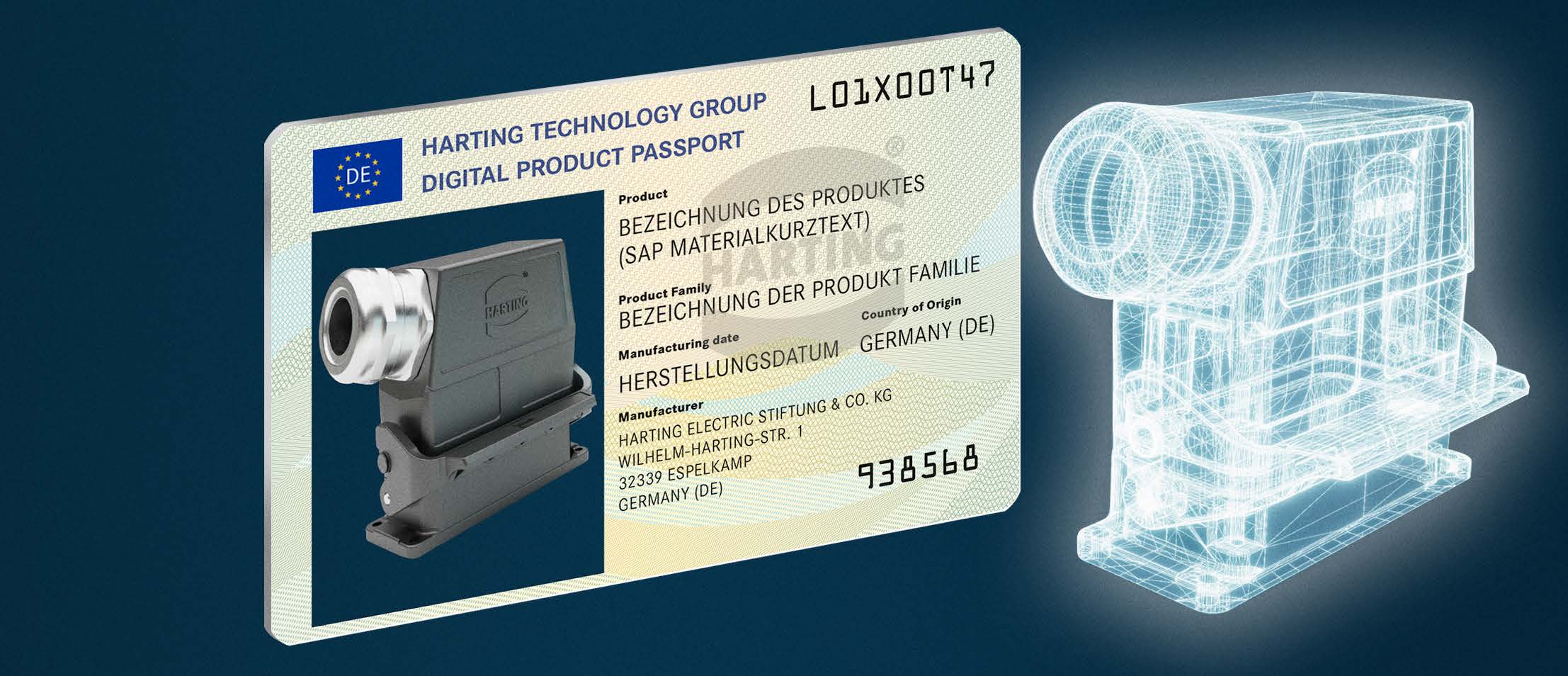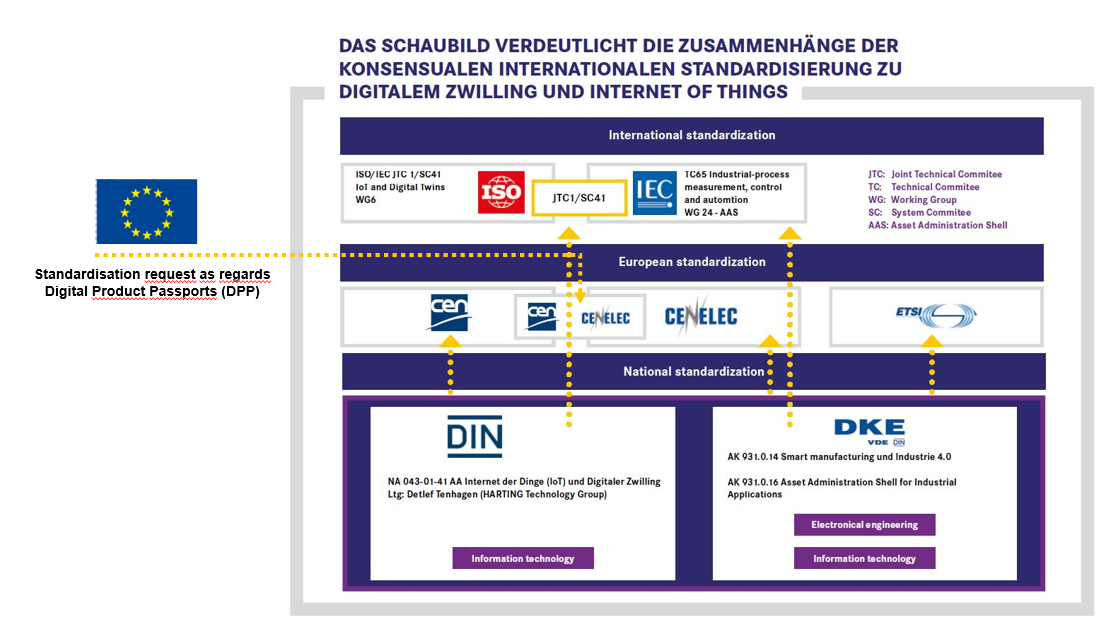The digital twin: Essential precondition for sustainability
Social megatrends are driving technology trends. With Connectivity+, the HARTING Technology Group is picking up on this and translating the corporate vision - "We want to shape the future with technologies for people" - into concrete products and applications. In view of these different
levels, the question arises: What do sustainability, and appropriate future technology solutions, have to do with digital twins and vice versa?
The HARTING Technology Group regards the digital twin as a holistic concept enabling the complete mapping and transparency of a real asset across the entire life cycle - from its birth, through renewable value creation (circular economy, "cradle to cradle"), and on to its final "energy recovery"("cradle to grave").
It is only by way of a digital twin that it is possible to determine information on the sustainability of an asset in the context of digitalisation. This is not, however, because a digital twin makes an asset more sustainable. Far more, because it creates the possibility of transparently listing and linking information about components/materials and their properties, and thereby ultimately optimising processes and bringing about verifiable improvements.
Let us consider, for example, the determination of the CO 2 footprint of products (Product Carbon Footprint (PCF) / Carbon Footprint of Products (CFP)): This is not directly apparent from the asset itself and can only be brought into a context with the real asset through a digital twin. Thanks to the digital twin, users gain insight into the various product lifecycle phases (development process, supply chain and production, logistics, utilisation, maintenance/repair...), as well as the components and materials used, and can only then make a meaningful statement in response to the question: Is the product actually sustainable or not?
This means: Sustainability can only be implemented sustainably by way of the digital twin.
At this point it is important to note the following: Environmental sustainability extends well beyond merely ascertaining the carbon footprint! Digitalisation - in terms of mapping a digital twin - needs to be applied in a much broader context; and especially when circular economy issues play a role (10Rs):
Refuse: How can the use of substances hazardous to health be avoided already during the design of a product?
Rethink: For example, can a product be rented instead of sold?
Reduce: How can a product be produced with the lowest possible consumption of natural resources and materials?
Reuse: How can a product be reused?
Repair: How can the reparability of a product be increased? How can a product be repaired?
Refurbish: How can individual components of a product be replaced?
Remanufacture: How can components of an old product be incorporated into the production of a new product?
Repurpose: How can a product be reused for another purpose?
Recycle: How can materials/components of a product be recycled?
Recover: How can raw materials used in the product be recovered?
The proposal for a new Ecodesign for Sustainable Products Regulation (ESPR) published by the European Commission on 30 March 2022 is based on the European Green Deal and the Circular Economy Action Plan of the European Union and envisages the introduction of a so-called Digital Product Passport (DPP). This product passport would serve as a collection of information about a product and its value chain. The standardised exchange of precisely this data and information throughout the entire product life cycle is the key element of the DPP. It should make it possible to answer the following questions - for various stakeholders such as the customer, persons performing repairs, recyclers, etc. - throughout the entire product life cycle:
- Product identification: What is the product in question? What identifiers (e.g. article number, customs tariff number, etc.) does it have?
- Manufacturer identification: Who produced the product, where and when?
- Material Information: What materials (ingredients, recycled content, rare earths, ...) and components is the product composed of?
- Technical data: What features does the product have?
- Declarations of conformity and markings: EU declaration of conformity, markings (CE, WEEE, ATEX, ... )
- Longevity: How can the product be repaired with which spare parts (availability, delivery time) using which tools (repair index)? What is the expected service life (Mean Time to Failure MTTF, Mean Time between Failure MTBF) or the durability/resistance to external influences such as mechanical loads or ageing processes?
- Recyclability: Can the product be separated into its different components and materials?
- Energy and resources: What are the environmental impacts (environmental footprints (CO 2 , H 2 O, NO X ), energy consumption) of the product? How were its raw materials extracted (environmental impacts during extraction/mining, but also corporate social responsibility, e.g.: child labour)?
- Use: How is the product used (optimally/efficiently)? (instruction manual)
- EOL: How is the product disassembled? How is it treated at the end of its life cycle? Which materials/components have to be added to the waste and how?
- Recycling capability: Can the product or its components/parts be recycled?
Type/Instance Data:
Both in the context of a Digital Twin (Asset Administration Shell) and in terms of the Digital Product Passport, a distinction is made between so-called type
and instance data.
While the type data is defined and specified during the development of a product, the focus is on collecting the instance data after it has been successfully tested and released in production. Therefore, the digital twin of each product consists of both cross-product type data and product-specific instance data.
For the HARTING Technology Group, the Digital Product Passport represents the next step in advancing the Digital Twin in concrete terms. The aim is to enrich the digital twin with the complete data of every component of a product and make it traceable. In this way, the Digital Twin serves as a data source for the Digital Product Passport and is relevant both at the customer or decision-maker level and at the supplier level, due to the following:
The transparent characteristics of a product are decisive for the selection process in terms of the desired sustainability. The Digital Twin or Digital Product Passport can only result in greater environmental sustainability if it is disseminated across the board and used universally. The HARTING Technology Group perceives the Asset Administration Shell, defined and specified by the Industrial Digital Twin Association (IDTA) and standardised within the framework of international Both in the context of a Digital Twin (Asset Administration Shell) and in terms of the Digital Product Passport, a distinction is made between so-called type and instance data. While the type data is defined and specified during the development of a product, the focus is on collecting the instance data after it has been successfully tested and released in production. Therefore, the digital twin of each product consists of both cross-product type data and product-specific instance data. standardisation (IEC), as the ideal choice here. Such uniformly practised standards represent the strong backbone for implementing sustainability in a goal-oriented manner.
The HARTING Technology Group will already be presenting a Digital Product Passport based on a Digital Twin (Asset Administration Shell at instance level) for selected parts of the product portfolio at SPS 2023, after approximately 18,000 products have already been equipped with a Digital Twin (Asset Administration Shell at type level) at this year’s HM 2023.
The following must be considered here. Components such as connectors that are passively installed devices that are themselves smart in turn, will not generally appear as an instance. Here, it is sufficient if the type is created and thereby integrated into the digital twin of the device, which usually functions as an instance. The situation is different for connectors that are used as highly complex installation components or as infrastructure components. These are additionally and definitely stated as an instance. Take, for example, the SmEC (Smart Electric Connector, see also tec.news issue 44), which has also already been defined as an instance in the DKE draft standardisation. Already the fact that the SmeC generates data in the application that can be used within the production plant to increase energy efficiency requires that the SmEC becomes an instance. This is due to the fact that product services are always linked to a one-to-one identification of the product and thereby to an active management shell of the same.


